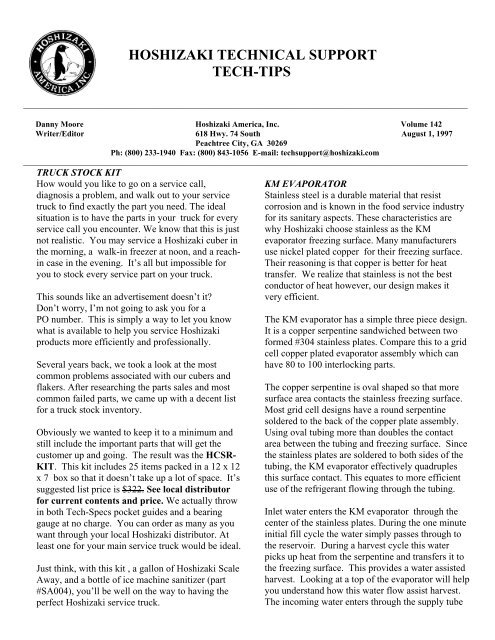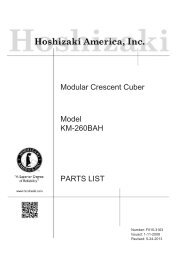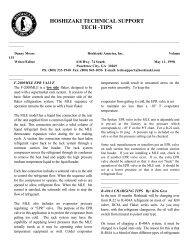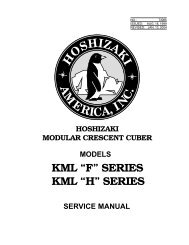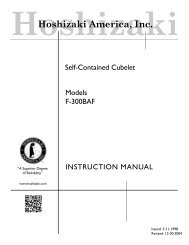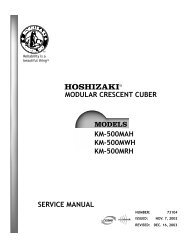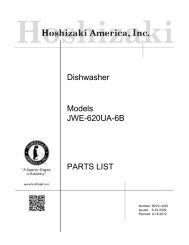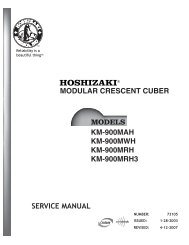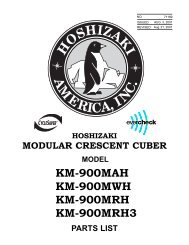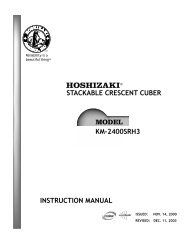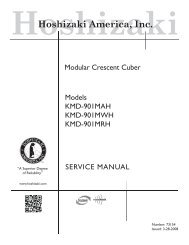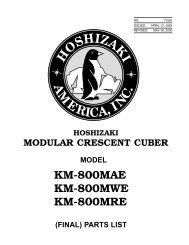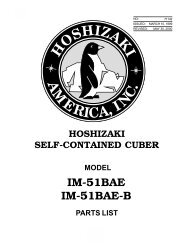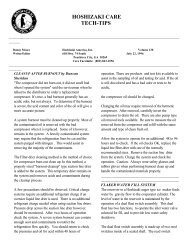hoshizaki technical support tech-tips - Hoshizaki America, Inc.
hoshizaki technical support tech-tips - Hoshizaki America, Inc.
hoshizaki technical support tech-tips - Hoshizaki America, Inc.
Create successful ePaper yourself
Turn your PDF publications into a flip-book with our unique Google optimized e-Paper software.
HOSHIZAKI TECHNICAL SUPPORT<br />
TECH-TIPS<br />
_____________________________________________________________________________________________________________<br />
Danny Moore <strong>Hoshizaki</strong> <strong>America</strong>, <strong>Inc</strong>. Volume 142<br />
Writer/Editor 618 Hwy. 74 South August 1, 1997<br />
Peachtree City, GA 30269<br />
Ph: (800) 233-1940 Fax: (800) 843-1056 E-mail: <strong>tech</strong><strong>support</strong>@<strong>hoshizaki</strong>.com<br />
_____________________________________________________________________________________________________________<br />
TRUCK STOCK KIT<br />
How would you like to go on a service call,<br />
diagnosis a problem, and walk out to your service<br />
truck to find exactly the part you need. The ideal<br />
situation is to have the parts in your truck for every<br />
service call you encounter. We know that this is just<br />
not realistic. You may service a <strong>Hoshizaki</strong> cuber in<br />
the morning, a walk-in freezer at noon, and a reachin<br />
case in the evening. It’s all but impossible for<br />
you to stock every service part on your truck.<br />
This sounds like an advertisement doesn’t it<br />
Don’t worry, I’m not going to ask you for a<br />
PO number. This is simply a way to let you know<br />
what is available to help you service <strong>Hoshizaki</strong><br />
products more efficiently and professionally.<br />
Several years back, we took a look at the most<br />
common problems associated with our cubers and<br />
flakers. After researching the parts sales and most<br />
common failed parts, we came up with a decent list<br />
for a truck stock inventory.<br />
Obviously we wanted to keep it to a minimum and<br />
still include the important parts that will get the<br />
customer up and going. The result was the HCSR-<br />
KIT. This kit includes 25 items packed in a 12 x 12<br />
x 7 box so that it doesn’t take up a lot of space. It’s<br />
suggested list price is $322. See local distributor<br />
for current contents and price. We actually throw<br />
in both Tech-Specs pocket guides and a bearing<br />
gauge at no charge. You can order as many as you<br />
want through your local <strong>Hoshizaki</strong> distributor. At<br />
least one for your main service truck would be ideal.<br />
Just think, with this kit , a gallon of <strong>Hoshizaki</strong> Scale<br />
Away, and a bottle of ice machine sanitizer (part<br />
#SA004), you’ll be well on the way to having the<br />
perfect <strong>Hoshizaki</strong> service truck.<br />
KM EVAPORATOR<br />
Stainless steel is a durable material that resist<br />
corrosion and is known in the food service industry<br />
for its sanitary aspects. These characteristics are<br />
why <strong>Hoshizaki</strong> choose stainless as the KM<br />
evaporator freezing surface. Many manufacturers<br />
use nickel plated copper for their freezing surface.<br />
Their reasoning is that copper is better for heat<br />
transfer. We realize that stainless is not the best<br />
conductor of heat however, our design makes it<br />
very efficient.<br />
The KM evaporator has a simple three piece design.<br />
It is a copper serpentine sandwiched between two<br />
formed #304 stainless plates. Compare this to a grid<br />
cell copper plated evaporator assembly which can<br />
have 80 to 100 interlocking parts.<br />
The copper serpentine is oval shaped so that more<br />
surface area contacts the stainless freezing surface.<br />
Most grid cell designs have a round serpentine<br />
soldered to the back of the copper plate assembly.<br />
Using oval tubing more than doubles the contact<br />
area between the tubing and freezing surface. Since<br />
the stainless plates are soldered to both sides of the<br />
tubing, the KM evaporator effectively quadruples<br />
this surface contact. This equates to more efficient<br />
use of the refrigerant flowing through the tubing.<br />
Inlet water enters the KM evaporator through the<br />
center of the stainless plates. During the one minute<br />
initial fill cycle the water simply passes through to<br />
the reservoir. During a harvest cycle this water<br />
picks up heat from the serpentine and transfers it to<br />
the freezing surface. This provides a water assisted<br />
harvest. Looking at a top of the evaporator will help<br />
you understand how this water flow assist harvest.<br />
The incoming water enters through the supply tube
and flows across the first pass of the serpentine. It<br />
then flows through the vertical cube separators to<br />
the next pass of the serpentine. This flowing action<br />
allows for even heat distribution and plays a big part<br />
in helping to release the KM cubes.<br />
During the freeze cycle the reservoir water is<br />
circulated to the outside freezing surface through the<br />
distribution tubes and guides. No additional water<br />
will enter through the supply tube during the freeze<br />
cycle. This circulating water will be cooled to 32° F<br />
and begin to form ice on the plates.<br />
The forming of the crescent cube is due to the fact<br />
that the serpentine is the coldest point on the<br />
freezing surface. The ice cube begins to form over<br />
the serpentine and continues to grow outward in the<br />
natural crescent shape.<br />
Once the individual crescent cubes are fully formed,<br />
the float switch will open to initiate the harvest<br />
cycle. As the heat from the serpentine is internally<br />
transferred to the stainless, the cube begins to melt<br />
away from the plate. A film of water is created<br />
between the cube and the plate surface. This water<br />
film holds the cube against the plate by capillary<br />
action. As the cube slides down the plate, the<br />
dimples which are formed into the flat freezing<br />
surface break this capillary hold and allow the cubes<br />
to release from the evaporator to fill the bin.<br />
As you can see, both durability and efficiency have<br />
been incorporated into the KM crescent evaporator.<br />
It takes a quality evaporator to make a quality<br />
cuber!<br />
_________________________________________<br />
_________________________________________<br />
SERVICE Q & A<br />
Question: The customer calls for service<br />
complaining of water dripping inside the storage<br />
bin. What is causing this to happen<br />
Answer: by Duncan Sheridan<br />
This complaint points to the external drain line. The<br />
drain line is probably improperly sized, blocked or<br />
restricted. I would suggest inspecting and cleaning<br />
the drain piping. The proper drain line size is ¾”<br />
OD and the largest water supply is ½” OD on KM<br />
cubers. With this piping arrangement, the machine<br />
should always be able to drain faster than the<br />
incoming water is supplied.<br />
I will always remember a service call I made some<br />
time ago on a machine that was located at a popular<br />
wholesale club. When I opened the ice bin storage<br />
door, I discovered the bin was filled with water to<br />
the bottom of the door opening! Upon further<br />
inspection I found the drain line outside the building<br />
which ran a total length of 200 ft. This long run<br />
allowed an excessive amount of slime to build up<br />
inside the pipe. After taking the drain line apart and<br />
using a garden hose to purge it, the drain did<br />
function. I informed the manager that a long drain<br />
line like this would probably fail again in the near<br />
future. Installing the run as short as possible, with<br />
the least amount of ells will allow drainage to flow<br />
properly and keep slime build-up from<br />
accumulating.<br />
If the drain line is not the problem, check to make<br />
sure the machine is level. Next, search for a<br />
possible water trail caused by shipping tape or<br />
slime. Look for water leaks inside the machine.<br />
Check the pump hoses and distributor connections<br />
to be sure they are secure. Also, inspect the<br />
reservoir stand pipe for slime buildup or a<br />
displacement cap out of position.<br />
Another area of concern would be the cube guides.<br />
Cube guides are the plastic grates located beneath<br />
the evaporator plates. Check to assure they are in<br />
place and not broken. If you find that the cube<br />
guides are broken, it could be the result of an<br />
evaporator freeze up. This would create a large ice<br />
slab that could break the cube guides or bounce<br />
them out of position when released. An evaporator<br />
that is frozen up can also allow water to leak into<br />
the ice storage bin. In this case, you must determine<br />
the cause of the freeze up and correct the problem.<br />
On rare occasions you may find a cracked or broken<br />
evaporator case tank [reservoir or sump tank]. You<br />
can field repair the tank with an ABS repair kit<br />
available through <strong>Hoshizaki</strong> Technical Support. If<br />
requested, we will ship a repair kit with instructions<br />
to you at no charge. In closing, keep in mind the<br />
general rule that one pound of water will melt five<br />
pounds of ice. As you can see, it is imperative that<br />
you correct any water leaking into the storage area.<br />
__________________________________________<br />
__________________________________________<br />
COMING NEXT MONTH...
1. Tubing Facts<br />
2. Video Reviews<br />
3. Service Q & A Volume 142 Page 2


